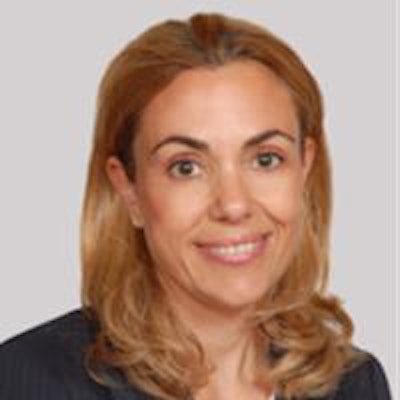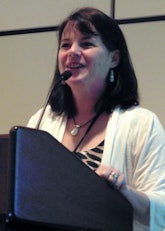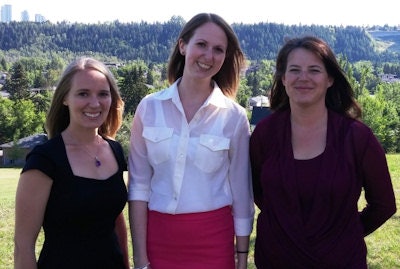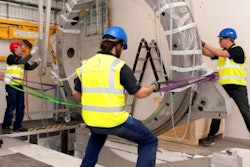
How well represented are women in the worldwide workforce of medical physicists? The IUPESM World Congress, held last month in Toronto incorporated five main congress themes, one of which was "Women in Biomedical Engineering and Medical Physics."
As part of this track, a dedicated conference session examined the current worldwide status of women in medical physics.
 Virginia Tsapaki, from Konstantopoulio General Hospital in Greece and secretary general of IOMP.
Virginia Tsapaki, from Konstantopoulio General Hospital in Greece and secretary general of IOMP.While studies have been performed looking at gender balance in science as a whole, the gender composition of the worldwide medical physicist workforce was previously unknown. This prompted IOMP, the International Organization for Medical Physics, to investigate the prevalence of female medical physicists across the globe.
"This represents the first-ever international study on women in medical physics," explained IOMP's secretary general Virginia Tsapaki, from Konstantopoulio General Hospital in Greece. Tsapaki presented the results of the study to an enthusiastic audience of conference delegates.
She described how IOMP sent out an online questionnaire to all national member organizations, as well as several countries that were members of regional organizations. To maximize response rate, the survey was kept brief, simply asking each country to submit the total number of medical physicists, the number of female medical physicists, and the gender of the person providing the data.
The key results
Sixty-six countries answered the survey, with 52% of responses provided by women. The total number of medical physicists cited was 17,024, representing more than three-quarters of the worldwide medical physics workforce. This included 4,807 women -- just 28% of the total.
"We saw big differences between continents and between individual countries," Tsapaki said. "For example, Africa has the lowest level of medical physics services in general, mirrored by a low number of women working in the field. Some countries reported zero female medical physicists."
Tsapaki highlighted, however, the large variation seen between the 19 African countries that replied, from 0% women in Ethiopia, Kenya, Tanzania, and Zimbabwe to 100% in Madagascar and Senegal (though these were percentages of very small total numbers). Overall, 561 medical physicists were reported in Africa, of which 220 (39%) were women. The percentage was boosted in particular by Egypt, with 75% of the country's 181 medical physicists being female.
Nine countries in the Middle East reported data. Again, a wide variation was seen, though not as great as for Africa. Of 449 medical physicists, 166 (37%) were women. Tsapaki noted Saudi Arabia reported the most medical physicists (250), but only 20% were women. In Asia, where nine countries replied, 24% of a total of 3,141 medical physicists were female. Values ranged from 15% (of 1,600 medical physicists) in China, to 60% (of 112) in Thailand, and 100% (of three) in Brunei.
Twelve Latin American countries responded to the survey, reporting 414 female medical physicists (36%) in a total workforce of 1,159. Again, a large variation was seen between countries, with Brazil, Nicaragua, and Cuba reporting the highest percentage of women (34% of 815, 44% of nine, and 37% of 49, respectively).
The U.S. has 6,330 medical physicists, the largest number reported among the regions studied, but only 1,316 (21%) of these were female. Finally, Tsapaki presented the data for the 16 countries in Europe that replied. Here, from a total of 5,384 medical physicists, 1,948 (36%) were women.
Tsapaki noted that despite the European Commission's target of a 40% representation of women, several European countries were far from this goal. In contrast, in some Middle Eastern and Asian countries, female medical physicists currently outnumber males. Finally, she pointed out that developed regions of the world such as the U.S. were expected to have a higher percentage of women, but actually had a lower percentage compared with many others.
"This was a first-level survey rather than a scientific study," Tsapaki said. Other limitations of this early work included some countries possibly providing speculative numbers or including related professions other than medical physicists, as well as the absence of countries including Canada, Australia, and New Zealand. She concluded that a more detailed study is now required, which IOMP hopes to perform in the near future.
The Canadian take
The conference session also included some country-specific presentations. Wendy Smith from the University of Calgary discussed whether there is a "leaky pipeline" for women in clinical medical physics in Canada.
 Wendy Smith from the University of Calgary speaking at the IUPESM World Congress.
Wendy Smith from the University of Calgary speaking at the IUPESM World Congress.Smith explained that in Canada, medical physicists typically follow up a graduate degree with a residency and then formally qualify after at least two years of clinical experience by becoming a member of the Canadian College of Physicists in Medicine (CCPM) upon passing the CCPM exams. After seven or more years of experience, they may then progress to become a CCPM fellow.
Smith and colleagues assessed the number of women at each stage in this representative career path, using data from public websites and informal surveys. They found that of 396 qualified medical physicists in Canada, 29% of CCPM members were female, similar to the 30% of women at the graduate student stage, but reducing to 17% of CCPM fellows.
"When you move to the fellowship level, that's where we see a drop in female participation," Smith said. "This corresponds closely to the number of women in higher academic levels across the board of sciences."
Smith pointed out that while the number of female CCPM fellows has grown slowly and steadily over the last couple of decades, the number of female CCPM members has increased rapidly in the last eight to 10 years.
"It is possible that these women are coming up through ranks and that they may join as fellows soon, but there are no data to prove this," she said.
Looking next at directorial roles, Smith found that of 10 graduate program directors, just one was a woman. For residency directors and clinical directors, the numbers were three out of 10 positions and three out of 21 positions, respectively. As for CCPM and COMP (Canadian Organization of Medical Physicists) board members, of seven to 10 board members at any one time, one or two were women. She also looked at the influence of female mentors influence, finding that out of 10 graduate programs, the two with the highest percentage of female students were both led by women.
 Wendy Smith (right) and graduate students Leigh Conroy (left) and Elizabeth Watt (center).
Wendy Smith (right) and graduate students Leigh Conroy (left) and Elizabeth Watt (center).Smith concluded that the number of women in clinical medical physics in Canada has increased substantially in the past 30 years and continues to increase, though currently, there are comparatively few women at the highest levels. This may, however, change in time as the increasing number of women entering the field advance through their careers. Importantly, she pointed out, of all the people that she had spoken to "none felt that they had been held back as a woman."
© IOP Publishing Limited. Republished with permission from medicalphysicsweb, a community website covering fundamental research and emerging technologies in medical imaging and radiation therapy.



















